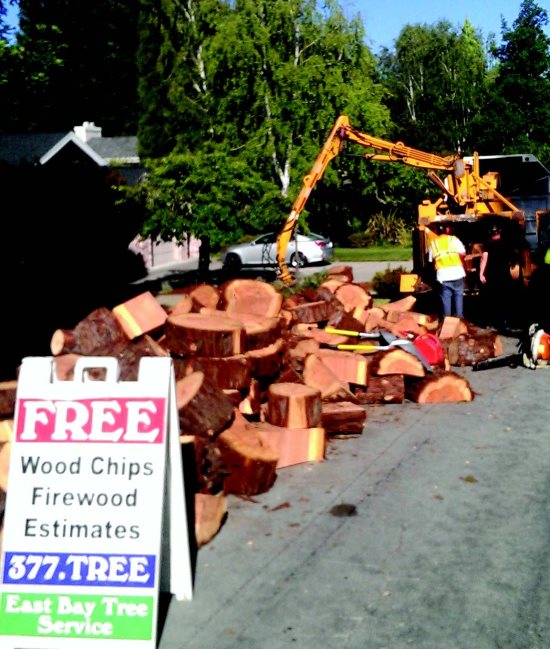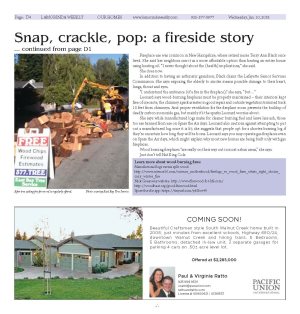| | Published January 10th, 2018
| Snap, crackle, pop: a fireside story
| | | By Cathy Dausman |  | | A gas fire on logs can be used on Spare the Air days. Photo Cathy Dausman |
Roman emperor Marcus Aurelius once said "a blazing fire makes flame and brightness out of everything that is thrown into it." More than 1,800 years later we're still burning wood. We may be more fire conscious and slightly more environmentally friendly than decades and centuries ago, but roast chestnuts and marshmallows still cry out for an open fire.
 So, what kind of wood should you use?
So, what kind of wood should you use?
 Michigan's Nick Greenway has developed an entire website devoted to all things firewood. Greenway says hardwoods take longer to season (dry) and burn hotter, slower and cleaner than conifer-softwoods. Pine, a softwood, is sappy, full of rosin and high in creosote - a dangerous byproduct in chimney flues. But softwoods may work well for campfires, simply because they are quicker and easier to light. And hardwood generally costs more.
Michigan's Nick Greenway has developed an entire website devoted to all things firewood. Greenway says hardwoods take longer to season (dry) and burn hotter, slower and cleaner than conifer-softwoods. Pine, a softwood, is sappy, full of rosin and high in creosote - a dangerous byproduct in chimney flues. But softwoods may work well for campfires, simply because they are quicker and easier to light. And hardwood generally costs more.
 Cut wood sells by the cord, or portions thereof. One cord of wood measures 128 cubic feet, and stacks roughly 4 by 4 by 8 feet. You can find wood through tree services that recycle their cuttings; or precut wood is available online through businesses and even Craigslist. Manufactured logs like Duraflame or Pres-to-Logs and small bundles of wood are available at hardware and grocery stores. Lamorinda Weekly even found bundled wood available in a nearby pharmacy.
Cut wood sells by the cord, or portions thereof. One cord of wood measures 128 cubic feet, and stacks roughly 4 by 4 by 8 feet. You can find wood through tree services that recycle their cuttings; or precut wood is available online through businesses and even Craigslist. Manufactured logs like Duraflame or Pres-to-Logs and small bundles of wood are available at hardware and grocery stores. Lamorinda Weekly even found bundled wood available in a nearby pharmacy.
 You can buy seasoned, ready-to-burn wood, or green wood at a discount and season it yourself. Firewood needs to air dry for a minimum of six months before it is burned. The water content of freshly cut wood runs as high as 50 percent; with seasoned wood the water content drops to between 15 and 20 percent. And the type of wood varies from oak, almond, cherry, elm, hickory, madrone or walnut.
You can buy seasoned, ready-to-burn wood, or green wood at a discount and season it yourself. Firewood needs to air dry for a minimum of six months before it is burned. The water content of freshly cut wood runs as high as 50 percent; with seasoned wood the water content drops to between 15 and 20 percent. And the type of wood varies from oak, almond, cherry, elm, hickory, madrone or walnut.
 One East Bay wood source says customers compare the aroma of their thoroughly-inspected-and-seasoned-for-two-years almond wood to that of fine wine. If you buy your wood in the spring or summer, demand is lower; buy it for use this winter and you'll pay a premium. Want it split, cut to length and stacked? The extra labor adds to the cost. And be sure to store the wood outside to keep ants, beetles, pill bugs or termites away from your hearth. And stack that wood away from the house for fire safety.
One East Bay wood source says customers compare the aroma of their thoroughly-inspected-and-seasoned-for-two-years almond wood to that of fine wine. If you buy your wood in the spring or summer, demand is lower; buy it for use this winter and you'll pay a premium. Want it split, cut to length and stacked? The extra labor adds to the cost. And be sure to store the wood outside to keep ants, beetles, pill bugs or termites away from your hearth. And stack that wood away from the house for fire safety.
 There are times, however, when you can't use a wood-burning fireplace. "We've had a record number of Spare the Air days this year," says Moraga-Orinda Fire District Fire Marshal Kathy Leonard, citing the smoke and ash that has made its way north from the current crop of Southern California wildland fires. The Bay Area Air Quality Management District is the public agency that regulates "stationary sources of air pollution" in the greater San Francisco area, including Contra Costa County. It is illegal to burn wood, fire logs, pellets or any other solid fuels in a fireplace, woodstove, or other wood-burning device between Nov. 1 and the end of February when a Spare the Air day is declared. The air district has even developed a free mobile phone app to notify users of Spare the Air days.
There are times, however, when you can't use a wood-burning fireplace. "We've had a record number of Spare the Air days this year," says Moraga-Orinda Fire District Fire Marshal Kathy Leonard, citing the smoke and ash that has made its way north from the current crop of Southern California wildland fires. The Bay Area Air Quality Management District is the public agency that regulates "stationary sources of air pollution" in the greater San Francisco area, including Contra Costa County. It is illegal to burn wood, fire logs, pellets or any other solid fuels in a fireplace, woodstove, or other wood-burning device between Nov. 1 and the end of February when a Spare the Air day is declared. The air district has even developed a free mobile phone app to notify users of Spare the Air days.
 Fireplace use was common in New Hampshire, where retired nurse Terry Ann Black once lived. She said her neighbors saw it as a more affordable option than heating an entire house using heating oil. "I never thought about the (health) implications," she said.
Fireplace use was common in New Hampshire, where retired nurse Terry Ann Black once lived. She said her neighbors saw it as a more affordable option than heating an entire house using heating oil. "I never thought about the (health) implications," she said.
 She does now.
She does now.
 In addition to having an asthmatic grandson, Black chairs the Lafayette Senior Services Commission. She says exposing the elderly to smoke means possible damage to their heart, lungs, throat and eyes.
In addition to having an asthmatic grandson, Black chairs the Lafayette Senior Services Commission. She says exposing the elderly to smoke means possible damage to their heart, lungs, throat and eyes.
 "I understand the ambiance (of a fire in the fireplace)," she says, "but..."
"I understand the ambiance (of a fire in the fireplace)," she says, "but..."
 Leonard says wood-burning fireplaces must be properly maintained - their interiors kept free of creosote, the chimney spark arrester in good repair and outside vegetation trimmed back 10 feet from chimneys. And proper ventilation for the fireplace room prevents the buildup of deadly carbon monoxide gas, but mainly it's the sparks Leonard worries about.
Leonard says wood-burning fireplaces must be properly maintained - their interiors kept free of creosote, the chimney spark arrester in good repair and outside vegetation trimmed back 10 feet from chimneys. And proper ventilation for the fireplace room prevents the buildup of deadly carbon monoxide gas, but mainly it's the sparks Leonard worries about.
 She says while manufactured logs make for cleaner burning fuel and leave less ash, those too are banned from use on Spare the Air days. Leonard also cautions against attempting to put out a manufactured log once it is lit; she suggests that people opt for a shorter-burning log if they're uncertain how long they will be home. Leonard says you may operate gas fireplaces even on Spare the Air days, which might explain why most new homes are being built only with gas fireplaces.
She says while manufactured logs make for cleaner burning fuel and leave less ash, those too are banned from use on Spare the Air days. Leonard also cautions against attempting to put out a manufactured log once it is lit; she suggests that people opt for a shorter-burning log if they're uncertain how long they will be home. Leonard says you may operate gas fireplaces even on Spare the Air days, which might explain why most new homes are being built only with gas fireplaces.
 Wood burning fireplaces "are really on their way out in most urban areas," she says.
Wood burning fireplaces "are really on their way out in most urban areas," she says.
 Just don't tell Nat King Cole.
Just don't tell Nat King Cole.
 Learn more about wood-burning fires:
Learn more about wood-burning fires:
 Manufactured logs versus split wood:
Manufactured logs versus split wood:
 http://www.science20.com/science_motherhood/firelogs_vs_wood_fires_whats_right_choice_cozy_winter_fire
http://www.science20.com/science_motherhood/firelogs_vs_wood_fires_whats_right_choice_cozy_winter_fire
 Nick Greenway website: http://www.firewood-for-life.com/
Nick Greenway website: http://www.firewood-for-life.com/
 http://woodheat.org/good-firewood.html
http://woodheat.org/good-firewood.html
 Spare the Air app: https://tinyurl.com/yb3lov49
Spare the Air app: https://tinyurl.com/yb3lov49


|
 | | After tree cutting free fire wood is regularly offered. Photo courtesy East Bay Tree Service | | | | | | | | | | | |





